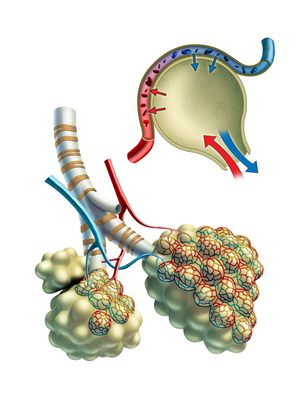What is COPD?
 COPD is a general term for the many conditions affecting your lungs. Pulmonary refers to the lungs. COPD is a progressive condition that worsens over time and makes it difficult to breathe.
COPD is a general term for the many conditions affecting your lungs. Pulmonary refers to the lungs. COPD is a progressive condition that worsens over time and makes it difficult to breathe.
What is COPD?
To understand COPD, you need to understand how the lungs work.
When you breathe, air goes down your windpipe into tubes in your lungs These tubes are called bronchial tubes or airways.
Pulmonar alveoliWithin the lungs, your bronchial tubes branch into thousands of smaller, thinner tubes called bronchioles. These tubes end in bunches of tiny round air sacs called alveoli.
Small blood vessels called capillaries run through the walls of these air sacs. When air reaches the air sacs, oxygen passes through the air sac walls into the blood in the capillaries. At the same time, carbon dioxide (a waste gas) moves from the capillaries into the air sacs. This process is called gas exchange.
The airways and air sacs are elastic. This means they are stretchy. When you breathe in, each air sac fills up with air like a small balloon. When you breathe out, the air sacs deflate and the air goes out.
 Lungs with COPD
Lungs with COPD
With COPD, the lungs are chronically obstructed.
In COPD, less air flows in and out of the airways because of one or more of the following:
- The airways and air sacs lose their elastic quality.
- The walls between many of the air sacs are destroyed.
- The walls of the airways become thick and inflamed.
- The airways make more mucus than usual, which can clog them.
There are two main conditions that create COPD: Chronic bronchitis, which involves a long-term cough with mucus; Emphysema, which involves destruction of the lungs, over time.
How do they create COPD?
In emphysema, the walls between many of the air sacs are damaged. As a result of this damage, the air sacs lose their shape and become floppy. This damage can destroy the walls of the air sacs, leading to fewer and larger air sacs instead of many tiny ones. With this condition the amount of gas exchange in the lungs is reduced. It is felt as “hard to breathe”.
In chronic bronchitis, the lining of the airways are constantly irritated and inflamed. This causes the lining to thicken. Lots of thick mucus forms in the airways, making it hard to breathe.
Most people who have COPD have both emphysema and chronic bronchitis. Thus, the general term “COPD” is more accurate.
Cigarette smoking is a leading cause of COPD. Many people who have COPD smoke or used to smoke.
Long-term exposure to other lung irritants—such as air pollution, chemical fumes, or dust contributes to COPD.
Symptoms
COPD can cause coughing that produces large amounts of mucus (a slimy substance), wheezing, shortness of breath, chest tightness, and other symptoms.
What happens and what to do about COPD
COPD is a major cause of disability, and it’s the third leading cause of death in the United States.
COPD develops slowly. Symptoms often worsen over time Severe COPD may prevent you from doing even basic activities like walking, cooking, or taking care of yourself.
This is a condition that isn’t passed between people. You can’t catch it from someone else.
COPD has no cure yet, as the medical doctors don’t know how to reverse the damage to the airways and lungs. Medical treatments and lifestyle changes can help you feel better, stay more active, and slow the progress of the disease.
Often medical doctors will prescribe drugs called control drugs:
Depending on the medicine, control drugs help you breathe easier by:
- Relaxing the muscles in your airways
- Reducing any swelling in your airways
Most COPD drugs need to be taken for a month before you will feel better.
Whenever you take drugs, you should check to see what the side effects are and what supplements you can take to give your body what it needs*
For instance, corticosteroids deplete the body of calcium, folate (B9), magnesium, potassium, selenium, Vitamin C, Vitamin D and zinc. There are many conditions created by deficiencies of these vitamins.
Helping COPD
You need a diet rich in protein. Protein builds organ tissue. You can also take the following:
Beta-carotene: protects your lungs from air pollution and smoke, helps the small air sacs in your lung to be cleaner and healthier.
Selenium: helps keep your lungs elastic
Vitamin A: turns into carotenes which your body needs for lung function.
Vitamin C: helps people breathe easier as it’s an anti-oxidant
Vitamin E: Preserves nutrients needed for building new cells, fights cellular aging and protects the lungs form oxidative damage **
Building Health
We always recommend you build health.
Eat a Healthy Diet and get all the proper nutrition your body needs to operate. Healthy Diets
*As with all drugs, they can create other nutritional deficiencies. See Drug Muggers Which Medications are Robbing Your Body of Essential Nutrients and How to Restore Them by Suzy Cohen, RPh (Kindle) or Paperback
Be sure to get whole food vitamins when looking for nutrition to help build health. What is Whole Food Vitamins?
Products we Recommend – whole food vitamins that do what they say they do
Fungal Link – There is Mayo Clinic research showing the fungus as a cause of chronic sinusitis. Since the sinuses are connected to the lungs, could not the fungus also be in the lungs?
COPD & Asthma – Addressing the Underlying Cause
Sign up to receive the MCVitamins Newsletter!
Up-to-date info on the latest health-related news happening in the world
(available in English only)

